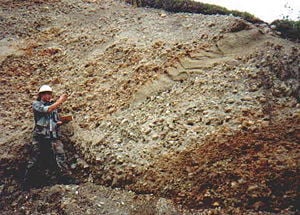Alluvium (from the Latin alluvius, from alluere, meaning "to wash against") is soil or sediment deposited by a river or other running water. Alluvium is typically made up of a variety of materials, including fine particles of silt and clay, and larger particles of sand and gravel. The deposits often contain valuable ores known as placer deposits. Flowing water associated with glaciers may also deposit alluvium, but deposits directly from ice are called glacial till, not alluvium.

How deposits are made
A river continually picks up and drops solid particles of rock and soil from its bed throughout its length. In areas where the river flow is fast, more particles are picked up than dropped. Conversely, in areas where the river flow is slow, more particles are dropped than picked up. Areas where more particles are dropped are called alluvial or flood plains, and the dropped particles are called alluvium. The process of deposition of alluvium is called alluviation. Even small streams make alluvial deposits, but it is in the flood plains and deltas of large rivers that large, geologically significant alluvial deposits are found.
Before alluvium can be deposited, the river or stream needs to run through areas that supply adequate material for the sediments. Areas that have a tropical climate or a high rate of tectonic uplift generate large amounts of sediment. By contrast, areas that are tectonically stable, cold, and dry usually have lower rates of sediment production.[1]
Amounts deposited
The amount of matter carried by a large river is enormous. The names of many rivers derive from the color that the transported matter gives the water. For example, the Huang He in China is literally translated "Yellow River," and the Mississippi River in the United States is also called Big Muddy. It has been estimated that the Mississippi River annually carries 406 million tons of sediment to the sea,[2] the Huang He carries 796 million tons, and the Po River in Italy carries 67 million tons.[3]
Value of alluvial deposits
Alluvium often contains valuable ores such as gold and platinum and a wide variety of gemstones. Such concentrations of valuable ores are known as placer deposits.
Throughout history, many shallow lakes have been filled in with alluvium to leave fertile plains (alluvial soils are often very fertile). The alluvial mud annually deposited by the Nile has enabled the Egyptians to grow crops since at least the fourth millennium B.C.E. without artificial fertilization.
Problems
Since the construction of the Aswan Dam on the Nile in Egypt, 95 percent of the alluvium deposits at the mouth of the Nubia-Nasser Lake are gone, thus depriving the Nile delta of its fertility. Since 1964, 3.8 billion cubic meters of sediments have deposited in this man-made lake. Proposals have been made to dredge this alluvium and pump it in slurry pipelines to shore where it can be used to fertilize the desert.[4]
See also
Notes
- ↑ Alluvium Retrieved October 23, 2008.
- ↑ Mathur, Anuradha, and Dilip da Cunha. 2001. Mississippi Floods: Designing a Shifting Landscape. New Haven, CT: Yale University Press. ISBN 0300084307
- ↑ Dill, William A. 1990. Inland Fisheries of Europe EIFAC technical paper, 52. Rome: Food and Agriculture Organization of the United Nations. ISBN 9251029997 Retrieved October 9, 2008.
- ↑ Abulnaga, Baha, and Moustafa El-Sammany. 2003. Mine Over Water. International Water Power & Dam Construction. 55 (11): 22-26. ISSN 0306-400X CODEN IWPCDM.
ReferencesISBN links support NWE through referral fees
- Marzo, M., and C. Puigdefábregas. 1993. Alluvial Sedimentation. Oxford, UK: Blackwell Scientific Publications. ISBN 0632035455
- Miall, Andrew D. 1996. The Geology of Fluvial Deposits: Sedimentary Facies, Basin Analysis, and Petroleum Geology. Berlin: Springer. ISBN 3540591869
- Nilsen, Tor Helge. 1985. Modern and Ancient Alluvial Fan Deposits. Benchmark Papers in Geology, v. 87. New York: Van Nostrand Reinhold. ISBN 0442267533
- Petts, Geoffrey E., and Ian Foster. 1985. Rivers and Landscape. London: E. Arnold. ISBN 0713164336
- Schumm, Stanley Alfred, Jean F. Dumont, and John Millard Holbrook. 2000. Active Tectonics and Alluvial Rivers. Cambridge, UK: Cambridge University Press. ISBN 0521661102
External links
All links retrieved July 23, 2023.
- Alluvium About.com: Geology.
- Alluvial Systems - Alluvium
Credits
New World Encyclopedia writers and editors rewrote and completed the Wikipedia article in accordance with New World Encyclopedia standards. This article abides by terms of the Creative Commons CC-by-sa 3.0 License (CC-by-sa), which may be used and disseminated with proper attribution. Credit is due under the terms of this license that can reference both the New World Encyclopedia contributors and the selfless volunteer contributors of the Wikimedia Foundation. To cite this article click here for a list of acceptable citing formats.The history of earlier contributions by wikipedians is accessible to researchers here:
The history of this article since it was imported to New World Encyclopedia:
Note: Some restrictions may apply to use of individual images which are separately licensed.
